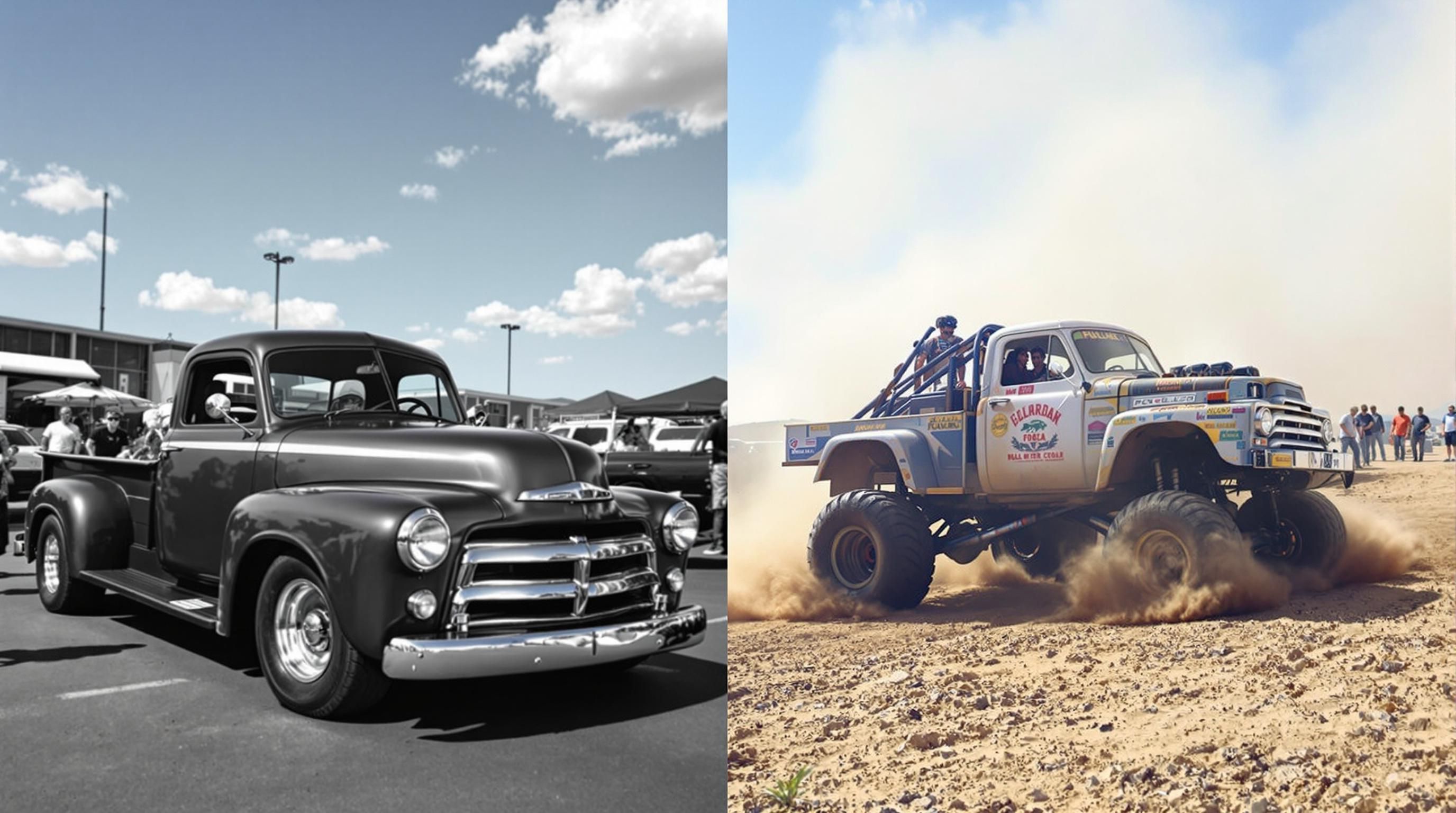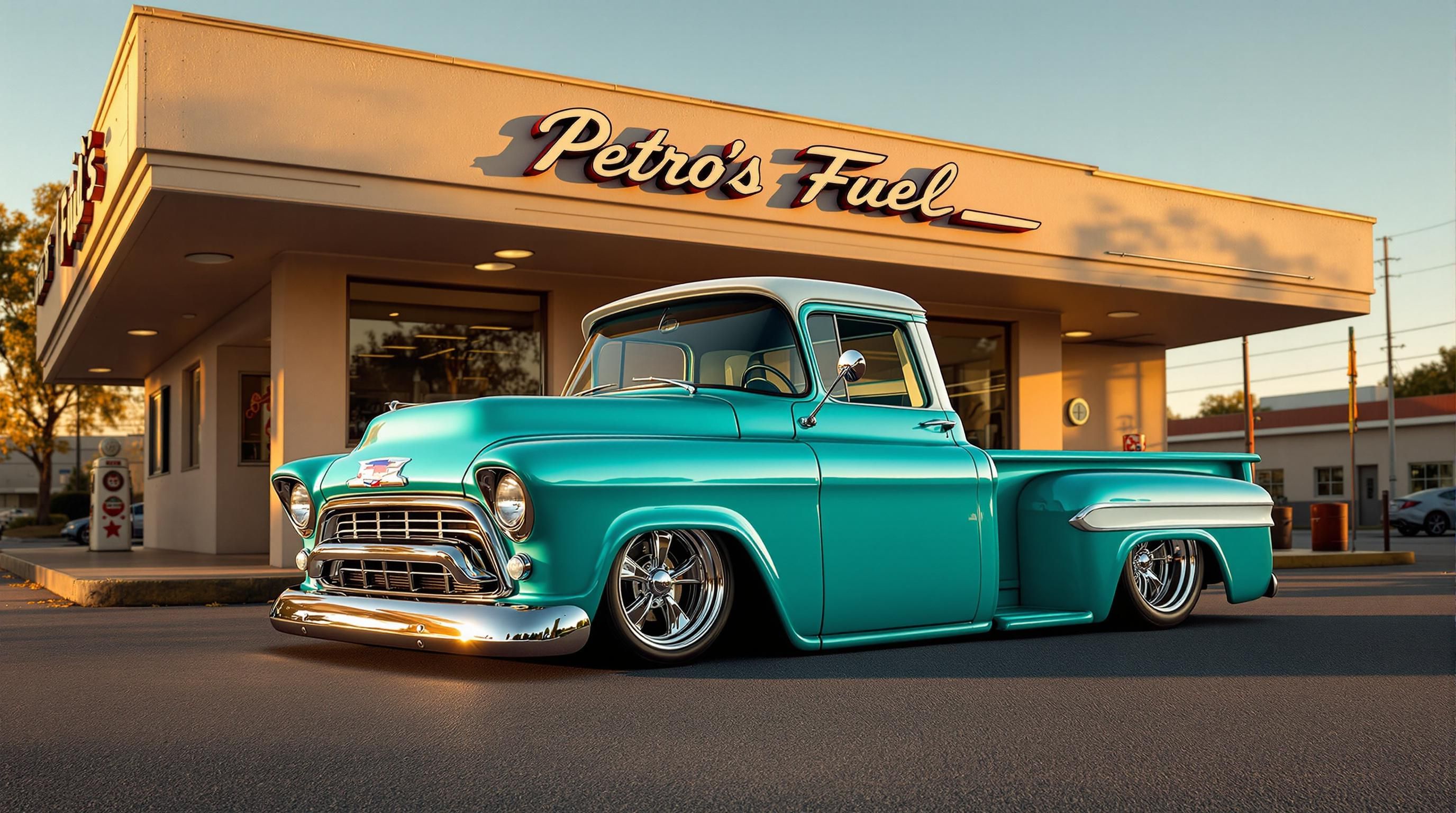Introduction to Classic Truck Values
The classic truck market has experienced remarkable growth in recent years, with collectors, enthusiasts, and investors recognizing the cultural significance and nostalgic appeal of vintage trucks. Whether you’re looking to buy your first classic pickup, sell a family heirloom, or simply determine the insurance value of your collection, understanding old truck values is essential.
Why Classic Truck Values Matter
The classic truck market is unlike the modern vehicle market, where standardized pricing is readily available. Factors such as rarity, historical significance, originality, restoration quality, and market trends all significantly impact old truck values. This guide will provide you with the knowledge and resources to navigate this complex market confidently.
Key Factors That Determine Classic Truck Values
Multiple elements influence the value of a vintage truck, and understanding these factors can help you make informed decisions whether buying, selling, or insuring a classic truck.
Make, Model, and Year
Not all vintage trucks command equal interest or value. Certain manufacturers, models, and production years have developed stronger followings than others:
Most Valuable Classic Truck Categories
Condition and Originality
The Condition Scale
Classic Truck Condition Assessment
The following factors determine a truck's condition rating and value:
- Body condition (rust, dents, panel alignment)
- Paint quality and authenticity
- Interior condition and correctness
- Mechanical functionality and reliability
- Chassis and undercarriage condition
- Original components vs. replacement parts
- Documentation and ownership history
- Restoration quality (if applicable)
Rarity and Production Numbers
Limited production trucks naturally command higher prices due to their scarcity. Special editions, rare option packages, and trucks with unusual factory configurations can significantly increase value.
How Rarity Affects Classic Truck Values
Examples of how production numbers influence market pricing
</tbody>
</table>
Modifications and Authenticity
The debate between originality and modifications is ongoing in the classic truck community:
- Original/Stock: Trucks in original, unmodified condition with factory-correct components typically appeal to purists and often hold value better long-term.
- Tastefully Modified: The “restomod” approach—combining classic aesthetics with modern performance upgrades—has gained significant popularity and market value in recent years.
- Heavily Modified: Extensively customized trucks appeal to a niche market, with values varying dramatically based on build quality and the specific modifications.
Evolution of Classic Truck Valuation Trends
- 1980s-1990s
Originality Premium
Original, unmodified trucks commanded the highest values as collectors focused on factory authenticity and preservation. - 2000s-2010s
Rise of the Restomod
Modified classic trucks with modern components gained acceptance and market value as usability became more important. - 2015-Present
Diverse Market
The market has bifurcated, with exceptional original examples and high-quality restomods both commanding premium prices.
Where to Find Reliable Classic Truck Values
Accurately valuing a classic truck requires consulting multiple sources to develop a complete picture of the market.

Professional Valuation Services
Hagerty Valuation Tools
Hagerty, a leader in classic vehicle insurance, maintains one of the most comprehensive classic vehicle valuation databases available. Their Valuation Tool covers over 40,000 classic vehicles, including trucks, with detailed condition-based pricing.
Key features of Hagerty’s valuation service:
- Values for vehicles across six condition ratings
- Historical price trends showing appreciation or depreciation
- “Price Guide” values derived from actual sales data, auction results, and dealer sales
- Regular updates reflecting current market conditions
NADA Guides
The National Automobile Dealers Association (NADA) provides valuation data for classic vehicles, though their coverage for trucks more than 20 years old can be limited. NADA uses a different methodology than Hagerty, providing Low, Average, and High retail values rather than condition-based valuations.
Old Cars Weekly Reports
Old Cars Weekly offers a dedicated pricing service for vintage vehicles, including classic trucks. Their database includes:
- Values for vehicles from the early 1900s through the 1990s
- Six condition-based price points
- Option pricing for factory-installed equipment
- Regional price variations
Classic Truck Valuation Service Comparison
Features of major valuation providers
| Category | Price | Notes |
|---|---|---|
| Standard Production Model | $15,000-$35,000 | Common trucks with standard features in good condition |
| Limited Production Variant | $35,000-$65,000 | Trucks with rare factory options or limited production runs |
| Extremely Rare Models | $65,000-$150,000+ | Models with fewer than 500 examples produced or surviving |
</tbody>
</table>
Market-Based Valuation Methods
While professional valuation services provide helpful guidelines, real-world market data often provides the most accurate picture of current values.

Auction Results
Recent auction results offer valuable insights into the current market for classic trucks. Major auction houses like Barrett-Jackson, Mecum, and RM Sotheby’s regularly feature vintage trucks, while online auction platforms like Bring a Trailer have become important indicators of market trends.
Notable Recent Classic Truck Auction Results
Recent Auction Sales
Notable classic truck auction results from 2021-2023
| Category | Price | Notes |
|---|---|---|
| Hagerty Valuation Tools | $69.99/year | Comprehensive coverage, six condition levels, historical trends |
| NADA Guides | Free basic access | Limited vintage coverage, three price points (low/average/high) |
| Old Cars Weekly Reports | $7.95 per report $29.95/year | Deep historical coverage, six condition levels, option valuations |
| Hemmings Price Guide | $14.95 per report | Personalized valuation with expert analysis |
</tbody>
</table>
Private Sales and Dealer Listings
While auction results make headlines, most classic trucks change hands through private sales or specialty dealers. Monitoring asking prices provides valuable context:
- Hemmings Motor News maintains an extensive classic car and truck marketplace with thousands of listings
- Specialty dealers like Classic Trucks and Gateway Classic Cars price inventory based on condition and market demand
- Online marketplaces like eBay Motors, Classic Cars, and Facebook Marketplace groups provide a broad view of asking prices
Truck Values by Era and Make
Pre-War Trucks (1920s-1930s)
Pre-war trucks represent the earliest era of truck collecting. These vehicles often appeal to historical vehicle collectors rather than traditional truck enthusiasts:
- Ford Model TT/AA/BB Trucks: $15,000-$45,000 depending on condition
- Chevrolet/GMC Pre-War Models: $18,000-$40,000 for restored examples
- Dodge/Fargo Models: $20,000-$50,000 for well-preserved specimens
Post-War Era (1946-1959)
The post-war era produced some of the most iconic and collectible American trucks, with distinctive styling that epitomizes the classic truck aesthetic:
- 1947-1955 Chevrolet Advanced Design: $25,000-$80,000
- 1948-1956 Ford F-Series: $30,000-$90,000
- 1946-1968 Dodge Power Wagon: $40,000-$150,000+
Modern Classics (1960-1980)
Trucks from this era benefit from greater usability, more modern features, and strong nostalgic appeal:
- 1967-1972 Chevrolet/GMC C/K Series: $20,000-$75,000
- 1961-1966 Ford F-Series: $25,000-$65,000
- 1972-1980 Dodge D/W Series: $15,000-$45,000
How to Determine Your Classic Truck's Value
Step-by-Step Valuation Process
Follow these steps to arrive at an accurate market value for your classic truck:
Gather documentation:
- Original window sticker (if available)
- Build sheet or factory documentation
- Service records and ownership history
- Restoration documentation (if applicable)
Identify exact specifications:
- Confirm the exact year, make, and model
- Document all factory options and equipment
- Verify the originality of engine, transmission, and other major components
- Research production numbers for your specific configuration
Assess condition objectively:
- Review each major component (body, paint, interior, mechanical, etc.)
- Document any deviations from factory specifications
- Note any restoration work or modifications
- Take comprehensive photographs documenting condition
Research comparable values:
- Check Hagerty, NADA, and other valuation guides
- Research recent auction results for similar trucks
- Review current asking prices for comparable vehicles
- Consult collector truck specialists for input
Account for market trends:
- Consider whether your truck’s model is appreciating or depreciating
- Factor in regional market variations
- Account for seasonal fluctuations in demand
Essential Classic Truck Valuation Resources
Hagerty Valuation Tools
Comprehensive database of classic vehicle values with condition-based pricing and historical trends.
NADA Classic Car Values
Traditional valuation guide providing low, average, and high retail values for vintage vehicles.
Hemmings Motor News
Market snapshot valuation service with personalized reports from Hemmings specialists.
Old Cars Weekly Price Guide
Detailed pricing information for vintage vehicles with six condition levels and option values.
Collector Car Market Report
Comprehensive market analysis with dedicated sections for classic trucks and detailed price guides.
American Collectors Insurance Values
Insurance perspective on classic vehicle valuation with tips for determining fair market value.
Special Considerations for Collector Truck Values
Several unique factors influence the classic truck market that differ from other collector vehicles:
Originality vs. Usability
Unlike some collector cars where originality is paramount, the truck market often rewards both preserved originals and thoughtfully upgraded examples:
- Work History: Trucks with documented commercial history can command premiums
- Patina: Original “survivor” trucks with natural aging are increasingly sought after
- Usability Upgrades: Modern disc brakes, power steering, and A/C can enhance rather than detract from value
- Drivetrain Swaps: Unlike many collector cars, modern engine swaps can substantially increase value in the truck market
Regional Value Variations
Classic truck values can vary significantly by region:
- Southwestern U.S.: Rust-free examples command 15-30% higher prices
- Rural Markets: Working trucks may be more valued for utility than collectibility
- International Markets: American trucks typically command premium prices in overseas markets
- Urban Centers: Restored, show-quality trucks may fetch higher prices in affluent metropolitan areas
Emerging Trends in Classic Truck Values
The market continues to evolve, with several notable trends affecting values:
- Growing Interest in 1980s-1990s Trucks: The newest generation of “emerging classics”
- 4x4 Premium: Four-wheel drive models typically command 25-40% higher values
- Specialized Models: Work trucks, stake beds, and other specialized configurations gaining collector interest
- Original Paint Value: Unrestored trucks with original finishes commanding surprising premiums
Common Questions About Classic Truck Values
How do I find the value of my old truck?
To determine your old truck's value, use multiple approaches:
- Check specialized valuation services like Hagerty, NADA, and Old Cars Weekly
- Research comparable sales on auction sites like Bring a Trailer and Barrett-Jackson
- Review current asking prices for similar trucks on Hemmings, eBay Motors, and classic truck dealer sites
- Consider getting a professional appraisal from a classic vehicle specialist
- Account for your truck’s specific condition, originality, options, and documented history
For the most accurate valuation, use these sources together rather than relying on a single resource.
Is there a Kelley Blue Book for older vehicles?
Kelley Blue Book (KBB) only provides values for vehicles up to 21 years old. For trucks older than this, you'll need to use specialized classic vehicle valuation resources instead:
- Hagerty Valuation Tools
- NADA Guides (which has some classic vehicle coverage)
- Old Cars Weekly Price Guide
- Hemmings Price Guide
These specialized resources better account for the unique factors that affect collector vehicle values, including condition variations, rarity, and historical significance.
How to appraise an old truck?
Appraising an old truck involves several key steps:
Documentation: Gather all available history, including ownership records, service history, and build information
Identification: Verify all VIN/serial numbers and decode them to confirm exact specifications
Condition Assessment: Objectively evaluate body, paint, interior, mechanical components, and chassis
Originality Check: Determine what components are original vs. replaced or modified
Market Research: Consult valuation guides, auction results, and dealer listings for comparable vehicles
Professional Input: Consider hiring a certified appraiser specializing in vintage vehicles for formal documentation
For insurance or legal purposes, a professional appraisal from a certified appraiser is often worth the investment.
How do you determine the fair market value of a truck?
Fair market value represents what a willing buyer would pay a willing seller, with neither under pressure to complete the transaction. For classic trucks, determine fair market value by:
Researching completed sales (not just asking prices) of comparable vehicles
Adjusting values based on your truck’s specific condition, originality, and options
Consulting multiple valuation resources like Hagerty and NADA
Accounting for current market trends in the collector truck segment
Considering regional market variations that might affect your specific location
The most accurate approach combines data from multiple sources rather than relying on a single guide or resource.
What classic trucks are increasing in value?
Several categories of classic trucks are currently showing strong appreciation:
First-generation Ford Broncos (1966-1977): Seeing dramatic price increases, with exceptional examples selling for over $200,000
1967-1972 Chevrolet/GMC C10 pickup trucks: Values have approximately doubled in the last 5-7 years
International Harvester Scout models: Growing recognition has pushed prices upward, especially for Scout 800 and Scout II models
1967-1972 Ford F-Series: Following the C10 trend with strong appreciation
Dodge Power Wagons: Both original military-derived models and civilian versions consistently appreciating
Japanese classics: Toyota Land Cruiser pickups and early Datsun/Nissan trucks beginning to see collector interest
The strongest appreciation is typically seen in well-preserved original examples and high-quality restorations/restomods.
Can I get classic truck values by VIN number?
Unlike modern vehicles, comprehensive VIN-based valuation services for classic trucks are limited:
- Major valuation services like Hagerty and NADA use make/model/year rather than VIN lookup
- VINs on pre-1981 vehicles contain less detailed information than modern VINs
- Many VIN decoding services focus primarily on verification rather than valuation
However, your truck’s VIN is still valuable for:
- Verifying the authentic year, make, and model
- Confirming factory options on some models (through build sheets or factory records)
- Researching ownership history through historical registrations
- Checking for theft recovery or salvage history
For the most accurate valuation, use the VIN to verify specifications, then consult traditional valuation resources.
What affects classic truck depreciation or appreciation?
Several factors influence whether a classic truck will appreciate or depreciate:Factors Driving Appreciation:
- Limited production numbers or rare options
- Cultural significance or notable history
- Rising popularity among younger collectors
- Media exposure (movies, TV shows, etc.)
- Celebrity ownership or significant provenance
- Preserved originality or exceptional restoration
Factors Leading to Depreciation:
- Excessive modifications that can’t be reversed
- Poor quality restorations
- Mechanical unreliability
- Difficult parts availability
- Market saturation of common models
- Shifting collector demographics and interests
Unlike modern vehicles, classic trucks have generally reached the bottom of their depreciation curve and now appreciate with the market, though the rate varies significantly by make, model, and condition.
Are modified classic trucks worth less than original ones?
The relationship between modifications and value is complex in the classic truck market:When Modifications Decrease Value:
- Amateur-quality work or poor craftsmanship
- Irreversible changes to rare original components
- Off-trend or dated customizations
- Modifications that compromise functionality
When Modifications Increase Value:
- Professional-quality "restomod" builds with modern engines/transmissions
- Period-correct modifications with historical significance
- Subtle upgrades that improve drivability (disc brakes, power steering)
- Modifications that preserve the truck’s aesthetic character
For investment purposes, exceptional original examples of rare models generally hold value most consistently. However, for many buyers, a tastefully modified truck that offers a better driving experience commands a significant premium over an uncomfortable original example.
Conclusion: The Future of Classic Truck Values
The classic truck market continues to evolve, with values shifting based on collector demographics, cultural trends, and the inherent utility these vehicles offer. Unlike some collector vehicles that serve primarily as display pieces, vintage trucks offer both aesthetic appeal and functional utility, broadening their appeal.
Several trends suggest the future direction of the market:
Generational Shift: As Baby Boomers age out of active collecting, Gen X and Millennial preferences are reshaping the market, with increased interest in trucks from the 1970s and 1980s.
Usability Premium: Trucks that combine classic aesthetics with modern reliability continue to command strong prices, with the gap between show-quality originals and high-quality restomods narrowing.
Market Expansion: The classic truck hobby continues to attract new enthusiasts, suggesting sustainable long-term demand, particularly for iconic models.
Alternative Fuel Consideration: As modern vehicles shift toward electrification, classic trucks with conversion potential may gain additional interest from environmentally conscious collectors.
Whether you’re considering a classic truck as an investment, a weekend pleasure vehicle, or a usable piece of automotive history, understanding the market dynamics and valuation factors outlined in this guide will help you make informed decisions. The classic truck market rewards knowledge, patience, and appreciation for these enduring symbols of American automotive heritage.
Additional Classic Truck Resources
Classic Trucks Magazine
Leading publication covering the classic truck hobby with restoration guides and market trends.
Bring a Trailer Auction Results
Curated online auction platform with searchable results database for past sales.
AACA Museum
Museum dedicated to automotive history with significant truck exhibits and educational resources.
Classic Truck Insurance Guide
Specialized insurance considerations for vintage truck owners, including agreed value policies.
Vintage Truck Magazine
Publication focused specifically on vintage truck history, restoration, and values.
Get a Professional Appraisal
Unsure about your item’s value? Our certified experts provide fast, written appraisals you can trust.
- Expert report with photos and comps
- Fast turnaround
- Fixed, upfront pricing
No obligation. Secure upload.
| Category | Price | Notes | |
|---|---|---|---|
| 1956 Ford F-100 Custom Cab | $96,250 | Barrett-Jackson, January 2023 | Concours-quality restoration, factory V8 |
| 1968 Chevrolet C10 Restomod | $82,500 | Mecum, March 2022 | Custom build with modern LS engine, premium upgrades |
| 1947 Dodge Power Wagon | $121,000 | Bring a Trailer, November 2022 | Frame-off restoration, documented history |
| 1970 Ford F-250 4x4 Highboy | $77,000 | Mecum, May 2023 | Original condition with 42,000 documented miles |




